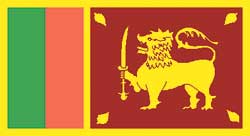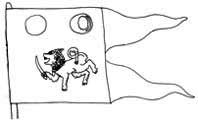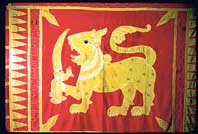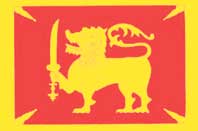
Sri Lanka’s National FlagSri Lanka celebrates 60 years of Independence on February 4, 2008. At the Independence celebrations in 1948, the first Prime Minister of independent Sri Lanka hoisted the Lion Flag.
The lion being identified as the national symbol of Sri Lanka dates back to the arrival of Prince Vijaya from India. It is said that on landing, he kissed the sand, called it thambapanni and planted a flag depicting a lion, they had with them, on the ground. This landing, complete with the prince hoisting the flag, is shown on a stone carving in Sanchi, India.
There is evidence that King Dutugemunu continued to use the Lion Flag as the royal standard, with the addition of the Sun and Moon to it, and the practice was carried on until the Sri Lankan Kingdom fell to the British during King Sri Wickrama Rajasinghe's regime in 1815. Ola manuscripts discovered from the Malwatta Vihara, Kandy states that this king used four flags; three of them depicted the lion while the other was the Davunda flag which he used during wars. The King of Kotte, Parakramabahu VI, is said to have used the same banner. The Lion Flag was also used by Sri Wickrama Rajasinghe, the last king of the country. On March 2, 1915, D.R. Wijewardena, owner of the prestigious Sinhala newspaper 'Dinamina' received a copy of the banner. He published a special edition and on the front page were the portraits of the last king and queen and the Lion Flag in colour. For the first time in nearly 100 years, the people of Lanka were given the chance to see for themselves the actual pattern of their National Flag, for which they were ever grateful. In 1948, A.L. Sinnelebbe, Member of Parliament, moved a motion in Parliament, that the Lion Flag should be adopted as the National Flag of Sri Lanka. This motion was seconded by Mr. A. E. Gooneshingha, M.P, Leader of the Labour Party. The first Prime Minister of independent Sri Lanka (then Ceylon), Hon. D. S. Senanayake hoisted a Lion Flag resembling that of Sri Wickrama Rajasinghe, in the island on February 4, 1948. On March 15, 1948, the National Flag Committee was formed. On March 2, 1951, the Lion Flag was accepted with a few changes as the country's National Flag. The crimson background with the Lion in gold was to be the same as before, but two vertical stripes of equal size and a gold border were added to complete it. When Sri Lanka became a Republic on March 22, 1972, the four pinnacles of the Flag, which were at the four corners on the crimson background, were replaced by Bo leaves.
|
|
||||||
|| Front
Page | News | Editorial | Columns | Sports | Plus | Financial
Times | International | Mirror | TV
Times | Funday
Times || |
| |
Reproduction of articles permitted when used without any alterations to contents and the source. |
© Copyright
2008 | Wijeya
Newspapers Ltd.Colombo. Sri Lanka. All Rights Reserved. |



